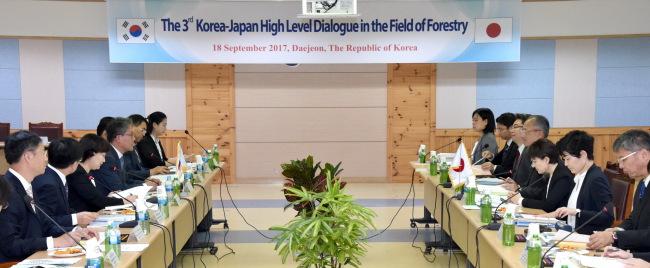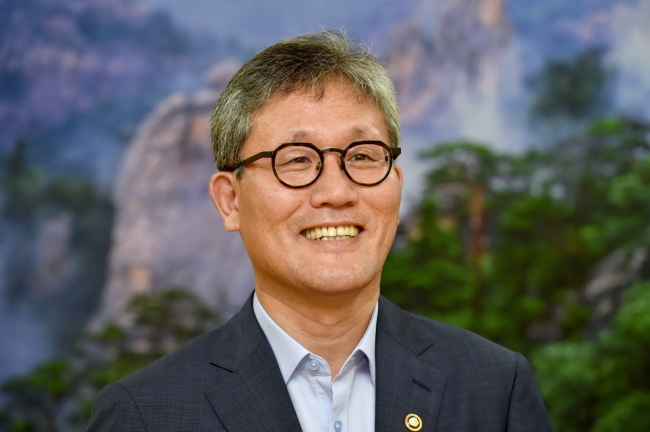Korea to benchmark Japan’s forestry job creation
By Son Ji-hyoungPublished : Sept. 18, 2017 - 16:15
With South Korea aiming to quadruple its forestry employment, Japan’s policy -- which has sparked an interest among the young generation -- could be the thing to aim for.
The high-level dialogue Monday between Korea and Japan held at the Korea Forest Service headquarters in Daejeon offered a nation suffering from chronic unemployment a chance to benchmark Japan’s track record of a recovery in forestry employment, the officials said.
The two-hour meeting was held in light of the Korean government seeking a breakthrough in the nation‘s prevailing youth unemployment, the ongoing retirement of baby boomers born between the mid-1950s and mid-1960s, as well as shortcomings in the workforce to address forestry issues.
The high-level dialogue Monday between Korea and Japan held at the Korea Forest Service headquarters in Daejeon offered a nation suffering from chronic unemployment a chance to benchmark Japan’s track record of a recovery in forestry employment, the officials said.
The two-hour meeting was held in light of the Korean government seeking a breakthrough in the nation‘s prevailing youth unemployment, the ongoing retirement of baby boomers born between the mid-1950s and mid-1960s, as well as shortcomings in the workforce to address forestry issues.

The meeting, attended by eight representatives of each nation including top forestry policymakers at a city some 140 kilometers south of Seoul, added spice to KFS Minister Kim Jae-hyun’s earlier efforts that came in line with the Moon Jae-in administration’s fiscal stimulus mainly intent on stimulating job creation and pursuing wage-led growth.
After taking office on July 18, Kim in August vowed to establish a 40-member team, led by the minister himself, to outline a policy to create forestry jobs and a nongovernmental committee to advise policymakers dedicated to the task.
By 2022, the KFS seeks to add over 45,000-strong workforce, from some current 15,000, mainly to enhance welfare impacts of forest and deal with disasters in forests, which cover 63 percent of the nation. Some 19,000 forestry workers will be added by the end of this year, according to the plan.
Japan, also with nearly 70 percent of its land occupied by woods, has ensured sustainable growth of forests, strengthened forest management and stabilized timber supply, all while conserving forestry employment.
The Forestry Agency of the neighboring nation, headed by Director General Shuji Oki since July, has strived to maintain the number of employees related to forests while increasing the proportion of youth employment in the field, thereby making a decline in the number of forestry jobs a thing of the past.
Japan’s young workers in forestry jobs accounted for 18 percent as of 2010, up from 10 percent in 2000, while over the cited decade, elderly employment there dropped to 21 percent from 30 percent, according to data from the Japanese Ministry of Internal Affairs and Communications.
The number of forestry workers over 30 years has shrunk to a third in Japan, from 146,322 in 1980 to 51,200 in 2010, the data also showed. A good sign, however, is that the degree of decline has narrowed to 2 percent over a five-year period beginning from 52,173 in 2005.
Japan’s Forestry Agency picked “Green Employment,” a career-building program to train on-site forestry engineers, as the main driving force of spurring the forestry employment in the high-level talks.
Some 15,000 new workers from 2003 to 2014, or about 4 in 10 new forest workers in the cited 11 years, went through the project that encompasses annual student grants of up to 1.5 million yen ($13,490) for a maximum two years, government subsidies of 90,000 yen a month for a three-year training program and state-sponsored additional training for further career enhancement.
Forestry jobs in Japan vary from timber suppliers and forest managers to furniture makers, forest therapists, forest foragers and consultants to community restoration.
After taking office on July 18, Kim in August vowed to establish a 40-member team, led by the minister himself, to outline a policy to create forestry jobs and a nongovernmental committee to advise policymakers dedicated to the task.
By 2022, the KFS seeks to add over 45,000-strong workforce, from some current 15,000, mainly to enhance welfare impacts of forest and deal with disasters in forests, which cover 63 percent of the nation. Some 19,000 forestry workers will be added by the end of this year, according to the plan.
Japan, also with nearly 70 percent of its land occupied by woods, has ensured sustainable growth of forests, strengthened forest management and stabilized timber supply, all while conserving forestry employment.
The Forestry Agency of the neighboring nation, headed by Director General Shuji Oki since July, has strived to maintain the number of employees related to forests while increasing the proportion of youth employment in the field, thereby making a decline in the number of forestry jobs a thing of the past.
Japan’s young workers in forestry jobs accounted for 18 percent as of 2010, up from 10 percent in 2000, while over the cited decade, elderly employment there dropped to 21 percent from 30 percent, according to data from the Japanese Ministry of Internal Affairs and Communications.
The number of forestry workers over 30 years has shrunk to a third in Japan, from 146,322 in 1980 to 51,200 in 2010, the data also showed. A good sign, however, is that the degree of decline has narrowed to 2 percent over a five-year period beginning from 52,173 in 2005.
Japan’s Forestry Agency picked “Green Employment,” a career-building program to train on-site forestry engineers, as the main driving force of spurring the forestry employment in the high-level talks.
Some 15,000 new workers from 2003 to 2014, or about 4 in 10 new forest workers in the cited 11 years, went through the project that encompasses annual student grants of up to 1.5 million yen ($13,490) for a maximum two years, government subsidies of 90,000 yen a month for a three-year training program and state-sponsored additional training for further career enhancement.
Forestry jobs in Japan vary from timber suppliers and forest managers to furniture makers, forest therapists, forest foragers and consultants to community restoration.

The meeting is expected to help policymakers craft detailed plans as soon as the Presidential Committee on Job Creation maps out initiatives, KFS officials said.
In July, the KFS unveiled a supplementary budget plans to pour in 50.1 billion won ($44.5 million) this year. Nearly four-fifths of it will be used to create thousands of jobs, according to the plan.
Using the budget, the KFS plans to employ some 3,000 forest conservation workers nationwide to control diseases such as pine wilt and stem wildfire, landslide or other types of natural disasters.
Korea has for decades suffered from pine wood nematodes. Since the first case of pine wilt disease by pests reported in 1988, Korea has sought ways to prevent pine forests from contracting the lethal diseases.
However, a chronic shortage of workforce devoted to forest disease control has left pine forests exposed to threats of extinction and undermined the sustainability of the forests.
The forest conservation workers’ role to spot host pine trees of the plague and remove them is significant to better prevent the disease’s spread, the KFS has said.
While Korea sees a substantial decrease in impact from pine needle gall midges, which have affected the greatest extent of forests in the nation among other pests, the pine wood nematodes have lately become a new threat to national forests. The area damaged by pine needle gall midges shrank to a third over 10 years as of 2015 to 49,960 hectares, while the area plagued by pine wilt disease doubled in a year as of 2013 to 11,550 hectares, showed data from the KFS.
In addition, over 800 forest instructor jobs will be created under the plan, as Korea sees growing demand with more and more tourists flock to forests.
Other than the main agenda items of forestry employment issues, the top forestry policymakers of Korea and Japan discussed plans to cooperate in projects to reduce greenhouse gas emission from deforestation and forest degradation. Moreover, the two nations sought ways to root out the trade of illegally logged lumber and make use of homegrown wood resources and biomass.
The high-level talk Monday marked the third, following the first bilateral forestry talk in Pocheon, Gyeonggi Province, in July 2012 and second in Tokyo in November 2014.
The Monday meeting, however, was the first to highlight the agenda of forestry employment.
By Son Ji-hyoung (consnow@heraldcorp.com) and Lee Kwon-hyoung(kwonhl@heraldcorp.com)
In July, the KFS unveiled a supplementary budget plans to pour in 50.1 billion won ($44.5 million) this year. Nearly four-fifths of it will be used to create thousands of jobs, according to the plan.
Using the budget, the KFS plans to employ some 3,000 forest conservation workers nationwide to control diseases such as pine wilt and stem wildfire, landslide or other types of natural disasters.
Korea has for decades suffered from pine wood nematodes. Since the first case of pine wilt disease by pests reported in 1988, Korea has sought ways to prevent pine forests from contracting the lethal diseases.
However, a chronic shortage of workforce devoted to forest disease control has left pine forests exposed to threats of extinction and undermined the sustainability of the forests.
The forest conservation workers’ role to spot host pine trees of the plague and remove them is significant to better prevent the disease’s spread, the KFS has said.
While Korea sees a substantial decrease in impact from pine needle gall midges, which have affected the greatest extent of forests in the nation among other pests, the pine wood nematodes have lately become a new threat to national forests. The area damaged by pine needle gall midges shrank to a third over 10 years as of 2015 to 49,960 hectares, while the area plagued by pine wilt disease doubled in a year as of 2013 to 11,550 hectares, showed data from the KFS.
In addition, over 800 forest instructor jobs will be created under the plan, as Korea sees growing demand with more and more tourists flock to forests.
Other than the main agenda items of forestry employment issues, the top forestry policymakers of Korea and Japan discussed plans to cooperate in projects to reduce greenhouse gas emission from deforestation and forest degradation. Moreover, the two nations sought ways to root out the trade of illegally logged lumber and make use of homegrown wood resources and biomass.
The high-level talk Monday marked the third, following the first bilateral forestry talk in Pocheon, Gyeonggi Province, in July 2012 and second in Tokyo in November 2014.
The Monday meeting, however, was the first to highlight the agenda of forestry employment.
By Son Ji-hyoung (consnow@heraldcorp.com) and Lee Kwon-hyoung(kwonhl@heraldcorp.com)








![[KH Explains] How should Korea adjust its trade defenses against Chinese EVs?](http://res.heraldm.com/phpwas/restmb_idxmake.php?idx=644&simg=/content/image/2024/04/15/20240415050562_0.jpg&u=20240415144419)











![[Today’s K-pop] Stray Kids to return soon: report](http://res.heraldm.com/phpwas/restmb_idxmake.php?idx=642&simg=/content/image/2024/04/16/20240416050713_0.jpg&u=)